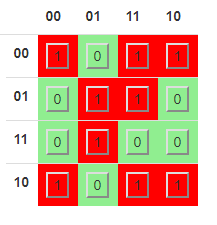I have following truth Table :
F(w,x,y,z) = Σ(0,2,5,7,8,10,12,13,14);
Truth Table
W X Y Z F
0 0 0 0 0 1
1 0 0 0 1 0
2 0 0 1 0 1
3 0 0 1 1 0
4 0 1 0 0 0
5 0 1 0 1 1
6 0 1 1 0 0
7 0 1 1 1 1
8 1 0 0 0 1
9 1 0 0 1 0
10 1 0 1 0 1
11 1 0 1 1 0
12 1 1 0 0 1
13 1 1 0 1 1
14 1 1 1 0 1
15 1 1 1 1 0
With the following Karnaugh Map
W X
Y
Z
I'm able to reduce this to the following SOP
~x~z + w~z + x~yz + ~wxy
My Professor explicitly told me that this function can be reduced to 2 SOP terms, but he doesn't have the time to demonstrate this as finals start this week.
I want to trust my professor on this, but I do not see how this can be reduced any more than it is.
How to prove that this can be reduced to 2 terms or prove that it can not be reduced to less than 4 ?

